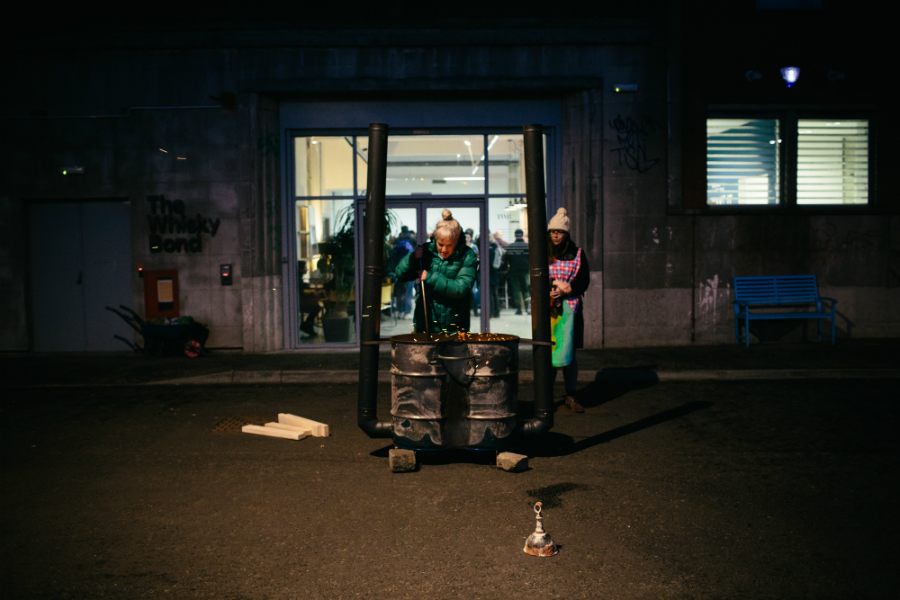Glasgow International — Reviewed (Part Two)

Roaring hot kilns, Edwardian swimming baths and getting lost: Anna Taylor reflects on a magical Glasgow International festival…
Glasgow is mid-way through its sixth International Art Festival. My visit so far has been one of immersive viewing experiences, the taking off of shoes and sharing of intimate spaces, both in minds and buildings. Crawling inside the interior of a bouncy castle set on the tiled floor of a disused Edwardian swimming baths, cross legged on the soft carpet of a dark paneled room and in the time-begotten conveniences opposite. Social and yet intimate, throughout the many festival venues we are being gathered to witness personal narratives and paradigm visions.
At Tramway, we sit sharing abandoned suitcases that spill from the boot of a stranded coach, from which Bedwyr Williams’ film is projected onto the wall of this grand-scale dystopian set. Echt (2014) is a humorist rendering of a near future in which the natural order is turned. The new ‘kings’ are ordained according to surreal hierarchies of consumption and children wretch from the stench of a rampant accumulation of stuff. A jeering mass of ordinary folk provoke council leaders to perform degrading dances as the new generation steal trainers from sleeping pensioners on the gymnasium floor of an un-specified temporary refuge location. It is an unrelenting series of events in which we, gathered in the post-catastrophe tram shed, are somehow implicated. Blinking as we find our way out of the misty dark space, the coach headlights cast our shadows on the back wall.
Disorientation turns out to be a repeated experience. Downstairs at Transmission, slide projections of vacuous scratched slides click as they switch to the backdrop of an atmospheric recorded arrangement of guttural and percussive mundane sounds that continually cause us to consider their source and our position. Arriving at The Modern Institute we walk straight past it, unable to locate the entrance, the gallery frontage overlaid by gaudily painted ghost train signage. Inside, a familiar materiality shifts towards something more threatening as we move through rooms clad in stifling pink carpet, to the periodic grinding of bells, metronomic ticking of alarms and the slurping of yellow water through plastic tubing. Passing through slits in the makeshift walls, our shoulders brush past crumbling underlay and tensed wires, scarcely seen.
The festival spans a vast area of Glasgow’s centre, which contains pockets of art spaces. The backdrop to many of the festival highlights is the historic architecture, which embeds shown works within the fabric of the city. The Director’s Programme finds two fitting disused venues in the community-salvaged Edwardian Govanhill Baths and the Victorian McLellan galleries, whose dark paneled claustrophobic corridors provide an eerie series of doorways through which we encounter Jordan Wolfson’s brilliant paradoxical survey of film and video works. This museum building was, until recently, occupied by students of the art school, but is now ordinarily vacant, its grandeur fading. But for the duration of the festival at least, it comes alive and plays an excellent host.
After a full day of navigating the festival’s extensive map of venues, our eyes and ears brimming, we cross the canal to the remotely located Glasgow Sculpture Studios, to attend Openaries, the second event in an accumulative project taking place over the festival, organised by artists Laura Aldridge and Anna Mayer. They consider the social aspects of making work, combining the ritual with the casual.
We are standing in the car park and it is cold and almost unfeasibly windy. In front of our huddled ensemble, a portable analogue firing kiln roars with flames as sparks fly and run like electric lines across the dark. A large, stick-frame is held up like a procession banner, and strung with a collection of small ceramic objects, each created and offered by artists working in the city. It is lowered into the flames for firing, accompanied by the chiming of a ceramic hand bell and spontaneous spoken performances. These individual fired objects will then collated and displayed as large-scale sculptures. As we look on and listen, the wind blows over all our beer bottles, marking out the shape of the gathering in notes blown on the air.
Anna Taylor
Anna Taylor is a writer based in West Yorkshire and works at Redeye, Manchester
Post-Glasgow International festival exhibitions continue at various venues across Glasgow, including The Briggait’s Reclaimed – The Second Life of Sculpture (until 2 May 2014), Transmission’s Beatriz Santiago Muñoz’s Post-Military Cinema (until 22 May), and Gabriel Kuri: All Probability Resolves into Form at the Common Guild (until 7 June 2014) – see here for full programme
See our GI Highlights here!
Read Glasgow International — Reviewed Part One





